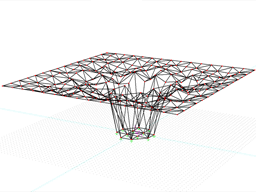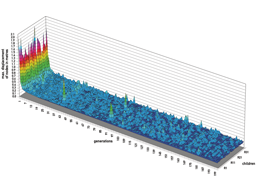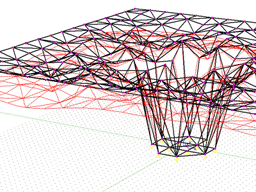|
designtoproduction profile team awards and publications how to find us | |||||

|


|
||||
|
Evolving Roof Performance based optimsation of a folded roof structure with genetic algorithms 2005 Geometry Consulting caad.designtoproduction ETH Zόrich Fabian Scheurer Engineering Bollinger + Grohmann Ingenieure Frankfurt Arne Hofmann << back |
This project is a study for a large roof assembled from steel members, developed in collaboration with Bollinger+Grohmann Engineering in Frankfurt. Topologically, the structure is a single plane, triangulated in a regular pattern of 289 nodes and 800 members. The third dimension is achieved by folding this plane: the z-coordinates of the nodes are irregularly changed within certain boundaries. The roof stands on a kind of foot where the plane is folded down to the ground. Structurally this poses a tricky problem. To achieve the necessary cantilevering capacity, it would be best to have deep folds running from the centre to the rim of the roof. But since there are no members spanning across the hole where the foot is going down, circular rings of members around the hole are the only way of keeping it from being drawn apart. Obviously those are two contradicting concepts. Since it was impossible to find a set of geometric rules for stability, the only way to determine the structural performance was to simulate the behaviour of the whole structure by help of an engineering analysis software in this case RStab by Dlubal and find a way to optimise it based on the results. Fortunately RStab provides a programming interface, so a complete structural model of the roof could be generated from a controlling software. It could then be analysed, and the results read back to the controller automatically. By encoding the z-coordinates of all nodes into a genome and using a genetic algorithm which allowed for crossover and mutation, the performance of the structure could be significantly improved. As a fitness criteria, the displacement of the nodes under self-weight was calculated by the analysis software, the worst node defining the inverse fitness for each individual. After 200 generations with 40 individuals each, the displacement repeatedly reached a minimum of 129mm at a cantilever of 25 metres and with a diameter of 193mm for the members an impressive value, according to the engineers. |
||||
|
Revision r1.12 - 20 Aug 2006 - 11:57 - ChristophSchindler Parents: WebHome |
|